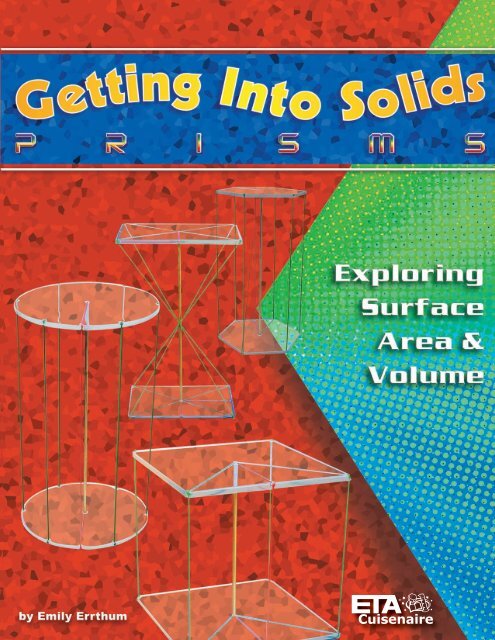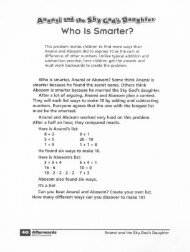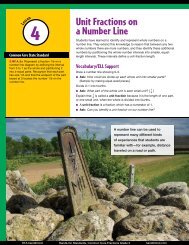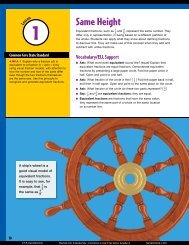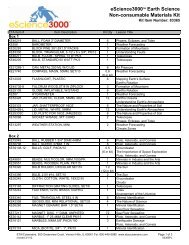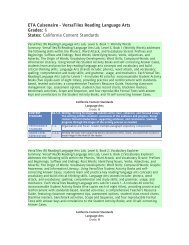Getting into Solids: Pyramids - ETA hand2mind
Getting into Solids: Pyramids - ETA hand2mind
Getting into Solids: Pyramids - ETA hand2mind
You also want an ePaper? Increase the reach of your titles
YUMPU automatically turns print PDFs into web optimized ePapers that Google loves.
I would like to dedicate this book to my brothers and sisters: Mary Lilja, Virginia<br />
Bellrichard, Thomas Errthum, Christine Breuer, Charles Errthum, and Joseph<br />
Errthum. A special thank you to Charles, for encouraging me to patent the original<br />
models. It is impossible for me to express my true appreciation for the guidance<br />
and support all of you have provided me over the years. You are wonderful brothers<br />
and sisters.<br />
I would like to also thank Vincent Kotnik III and his wife, Cathy, who have been<br />
like a brother and sister to me. Vincent, you have been a wonderful friend and a<br />
great colleague. Thank you for mentoring me my first three years of teaching; you<br />
guided me well. Cathy, your positive attitude is an inspiration not only for me, but<br />
for anyone who meets you. I cherish the fact that I have both of you as friends.<br />
I have great respect and admiration for each of you. You are truly very special people.<br />
Please know that you are all near and dear to my heart.<br />
Emily Errthum<br />
<strong>ETA</strong> 75545<br />
Copyright ©2005 by Classroom Products. All rights reserved.<br />
Except as permitted under the United States Copyright Act and where expressly permitted, no part of this publication<br />
may be reproduced or distributed in any form by any means, or stored in a database or retrieval system,<br />
without prior written permission from the publisher. However, the publisher grants permission to classroom teachers<br />
to reproduce activity pages for one classroom only. The reproduction of any part for an entire school or system<br />
is strictly prohibited.<br />
Send all inquiries to:<br />
<strong>ETA</strong>/Cuisenaire ®<br />
500 Greenview Court<br />
Vernon Hills, IL 60061
INTRODUCTION<br />
Prior to <strong>Getting</strong> Into <strong>Solids</strong>, the solids were just that — solid. The lateral faces were made of plastic<br />
that tightly enclosed each solid. It was impossible to get inside the model to identify the height, apothem,<br />
radius, central angle measure, and the right triangles needed to find missing lengths.<br />
Leeanne Branham, from Fresno Pacific University, best identified the problem with solids in the March<br />
1998 issue of CMC ComMuniCator. In the article “<strong>Getting</strong> Into <strong>Pyramids</strong>” Leeanne wrote, (referring to<br />
the solid lateral face models) “but one drawback that these models all share was that I couldn’t get<br />
inside them.” Her article was designed, with worksheets, to assist students in solving surface area and<br />
volume problems by redrawing the parts of a figure on one-dimensional paper. I identified with her<br />
frustration as well as observed the frustration level of my own students. This inspired me to design the<br />
three-dimensional open models, <strong>Getting</strong> Into <strong>Solids</strong> — <strong>Pyramids</strong> and <strong>Getting</strong> Into <strong>Solids</strong> — Prisms.<br />
These new models literally allow the learner to “get inside” the solid.<br />
The <strong>Getting</strong> Into <strong>Solids</strong> — Prisms models allow students to:<br />
A. Identify the different parts of the regular prisms and right cylinders by colors.<br />
1. Brass rod – height<br />
2. Green string – lateral edge, height<br />
3. Etched green line on the base – radius<br />
4. Etched red line on the base – apothem<br />
5. Etched blue line on the base – base edge<br />
B. Attach numbers to the model for ease of visualization.<br />
1. Write on the plexiglass base with overhead markers<br />
2. Attach stick-on notes — with unit measure — on the height<br />
C. Employ all learning styles.<br />
1. Visual<br />
2. Auditory (when guided by the teacher or students teaching others in groups)<br />
3. Kinesthetic/Tactical<br />
1
Section One of this book contains reproducible worksheets for finding the surface area and volume of regular<br />
prisms and right cylinders. Each model has three worksheets. The first worksheet includes dimensions.<br />
The second worksheet serves as an answer key for the first worksheet. Finally, the third worksheet<br />
is blank so that the instructor or student can assign dimensions to any illustration — specific from<br />
a classroom textbook. The worksheets in this section are intended to guide students through a frequently<br />
long and difficult process. Helping students to organize their mathematical steps provides students<br />
with immediate success and, as a result, promotes a positive experience for finding surface area<br />
and volume.<br />
Section Two of this book (beginning on page 22) also contains reproducible worksheets for finding the<br />
surface area and volume of regular prisms and right cylinders. This section is less structured than<br />
section one. It is designed for students to take on the challenge of organizing their thought process in<br />
a logical order. Students will need to show multiple mathematical steps to yield the desired result. With<br />
prior work in section one, students are easily able to make this transition. Students may find it more<br />
difficult, but many will show extreme growth in their organizational skills. Section two utilizes concepts<br />
from the book <strong>Getting</strong> Into <strong>Solids</strong> – <strong>Pyramids</strong>. Students will need to know how to calculate the volume<br />
of a pyramid and the volume of a cone. Brass rods are provided to build and display each of the six<br />
prism models at one time. A shorter brass rod is included to allow the construction of a 16 cm x 16<br />
cm x 16 cm cube, or to change the height of any of the other models.<br />
Easy to assemble instructions: (see diagram below)<br />
Green String<br />
1. Screw the brass rod <strong>into</strong> polygon center (representing height).<br />
2. Screw a congruent polygon on the opposite side of the brass rod.<br />
3. Slide the end of the green string (representing lateral edge, height)<br />
<strong>into</strong> the notch of each base. The string should be perpendicular to<br />
the bases.<br />
4. Repeat Step 3 for all green strings, alternating from side to side.<br />
5. Stick-on notes can be attached to the green string, with unit<br />
measure (representing lateral edge, height).<br />
6. Turning one of the prism bases 180º will create symetrical<br />
pyramid models. Use twist ties, string, or tape to retain the<br />
desired shape.<br />
Brass Rod<br />
Notches<br />
Twist to Create <strong>Pyramids</strong><br />
Polygon<br />
Base<br />
2
Vocabulary for Regular Prisms and Right Cylinders<br />
L.A. = lateral area P = perimeter of base r = radius<br />
S.A. = surface area B = area of base h = height<br />
V = volume<br />
π = pi<br />
Formulas for Regular Prisms and Right Cylinders<br />
Regular Prisms<br />
Right Cylinders<br />
L.A. = P h<br />
L.A. = 2 π r h<br />
S.A. = L.A. + 2 B<br />
S.A. = L.A. + 2 B<br />
S.A. = P h + 2 B S.A. = 2 π r h + 2 π r 2<br />
V = B h<br />
V = B h<br />
V = π r 2 h<br />
TABLE OF CONTENTS<br />
Section One: Finding Surface Area and Volume of Regular <strong>Solids</strong><br />
Cylinder. ..................................................4<br />
Triangular Prism. ............................................7<br />
Cube. ...................................................10<br />
Rectangular Prism ..........................................13<br />
Pentagonal Prism ...........................................16<br />
Hexagonal Prism ...........................................19<br />
Section Two: Challenge Problems<br />
Finding Surface Area and Volume of Regular <strong>Solids</strong><br />
Two Attached Rectangular Prisms ...............................22<br />
Rectangular Prism and Regular Square Pyramid ......................24<br />
Two Cylinders; Maximizing Lateral Area ............................26<br />
Cylinder with Two Cones Inserted ................................28<br />
Rectangular Prism with a Rectangular Hole .........................30<br />
Rectangular Prism with a Cylindrical Hole. ..........................32<br />
3
Name __________________________________________<br />
Find Surface Area and Volume<br />
of the regular solid.<br />
Fill in the blanks and show all your work.<br />
Name of the solid: _______________________________<br />
GETTING INTO SOLIDS — PRISMS<br />
Worksheet 1<br />
diameter = 7 ft<br />
height = 20 ft<br />
Equation for formula: S.A. = _____________________________<br />
Equation for formula: V = ________________________________<br />
First, I will solve for the area of the Base, which is a _____________________________.<br />
Describe your process through a series of clearly shown mathematical steps.<br />
B = ____________________<br />
Next, I will solve for the Lateral Area, which is a _____________________________.<br />
Describe your process through a series of clearly shown mathematical steps.<br />
L.A. = ____________________<br />
Write the equations. S.A. = __________________________ V = __________________________<br />
Replace variables with<br />
their value. S.A. = __________________________ V = __________________________<br />
Solve the equations.<br />
(Show all algebraic steps.) S.A. = __________________________ V = __________________________<br />
4
Name __________________________________________<br />
Find Surface Area and Volume<br />
of the regular solid.<br />
Fill in the blanks and show all your work.<br />
Right Cylinder<br />
Name of the solid: _______________________________<br />
GETTING INTO SOLIDS — PRISMS<br />
Worksheet 1: Answer Key (difficulty — medium)<br />
diameter = 7 ft<br />
height = 20 ft<br />
L.A. + 2 B<br />
Equation for formula: S.A. = _____________________________<br />
B h<br />
Equation for formula: V = ________________________________<br />
circle<br />
First, I will solve for the area of the Base, which is a ____________________________.<br />
Describe your process through a series of clearly shown mathematical steps.<br />
First, I will find the radius, r.<br />
Now I can find the area of the base.<br />
r = 1 / 2 diameter B = π r 2<br />
r = 1 / 2 (7) B = π (3.5) 2<br />
r = 3.5 B = 12.25π<br />
12.25 π ft 2 , rectangle<br />
B = ____________________<br />
Next, I will solve for the Lateral Area which is a _____________________________.<br />
Describe your process through a series of clearly shown mathematical steps.<br />
L.A. = 2 π r h<br />
L.A. = 2 π (3.5) (20)<br />
L.A. = 140 π<br />
140 π ft 2 L.A. + 2 B B h<br />
L.A. = ____________________<br />
Write the equations. S.A. = __________________________ V = __________________________<br />
Replace variables with<br />
their value. S.A. = __________________________ V = __________________________<br />
140 π + 2 (12.25 π) 12.25 π (20)<br />
S.A. = 140 π + 24.5 π<br />
Solve the equations.<br />
(Show all algebraic steps.) S.A. = __________________________ 164.5 π ft 2 V = __________________________<br />
245 π ft 3<br />
S.A. = 516.79 ft 2 V = 769.69 ft 3<br />
5
Name __________________________________________<br />
Find Surface Area and Volume<br />
of the regular solid.<br />
GETTING INTO SOLIDS — PRISMS<br />
Worksheet 2<br />
Fill in the blanks and show all your work.<br />
Name of the solid: _______________________________<br />
Equation for formula: S.A. = _____________________________<br />
Equation for formula: V = ________________________________<br />
First, I will solve for the area of the Base, which is a ____________________________.<br />
Describe your process through a series of clearly shown mathematical steps.<br />
B = ____________________<br />
Next, I will solve for the Lateral Area which is a _____________________________.<br />
Describe your process through a series of clearly shown mathematical steps.<br />
L.A. = ____________________<br />
Write the equations. S.A. = __________________________ V = __________________________<br />
Replace variables with<br />
their value. S.A. = __________________________ V = __________________________<br />
Solve the equations.<br />
(Show all algebraic steps.) S.A. = __________________________ V = __________________________<br />
6
Name __________________________________________<br />
Find Surface Area and Volume<br />
of the regular solid.<br />
Fill in the blanks and show all your work.<br />
Name of the solid: _______________________________<br />
GETTING INTO SOLIDS — PRISMS<br />
Worksheet 3<br />
4 in.<br />
18 in.<br />
Equation for formula: S.A. = _____________________________<br />
Equation for formula: V = ________________________________<br />
First, I will solve for the area of the Base, which is a ____________________________.<br />
Describe your process through a series of clearly shown mathematical steps.<br />
B = ____________________<br />
Next, I will solve for the Lateral Area, which is a _____________________________.<br />
Describe your process through a series of clearly shown mathematical steps.<br />
L.A. = ____________________<br />
Write the equations. S.A. = __________________________ V = __________________________<br />
Replace variables with<br />
their value. S.A. = __________________________ V = __________________________<br />
Solve the equations.<br />
(Show all algebraic steps.) S.A. = __________________________ V = __________________________<br />
7
Name __________________________________________<br />
Find Surface Area and Volume<br />
of the regular solid.<br />
Fill in the blanks and show all your work.<br />
Triangular Prism<br />
Name of the solid: _______________________________<br />
GETTING INTO SOLIDS — PRISMS<br />
Worksheet 3: Answer Key (difficulty - medium)<br />
4 in.<br />
18 in.<br />
Equation for formula: S.A. = _____________________________<br />
Equation for formula: V = ________________________________<br />
First, I will solve for the area of the Base, which is a ____________________________.<br />
Describe your process through a series of clearly shown mathematical steps.<br />
B = S 2 3<br />
4<br />
B = 4 2 3<br />
4<br />
B = 4 3<br />
L.A. + 2 B<br />
B h<br />
triangle<br />
B = ____________________<br />
4 3 in. 2 rectangle<br />
Next, I will solve for the Lateral Area, which is a _____________________________.<br />
Describe your process through a series of clearly shown mathematical steps.<br />
First I will find the<br />
Now I can find the<br />
perimeter of the base, P.<br />
lateral area, L.A.<br />
P = 3 S<br />
L.A. = P h<br />
P = 3 (4) L.A. = 12 (18)<br />
P = 12 L.A. = 216<br />
L.A. = ____________________<br />
Write the equations. S.A. = __________________________ V = __________________________<br />
Replace variables with<br />
their value. S.A. = __________________________ V = __________________________<br />
Solve the equations.<br />
(Show all algebraic steps.) S.A. = __________________________ V = __________________________<br />
8<br />
216 in. 2 L.A. + 2 B B h<br />
216 + 2 (4 3 ) 4 3 (18)<br />
216 + 8 3 in. 2 72 3 in. 3<br />
S.A. = 229.86 in. 2 V = 124.71 in. 3
Name __________________________________________<br />
Find Surface Area and Volume<br />
of the regular solid.<br />
GETTING INTO SOLIDS — PRISMS<br />
Worksheet 4<br />
Fill in the blanks and show all your work.<br />
Name of the solid: _______________________________<br />
Equation for formula: S.A. = _____________________________<br />
Equation for formula: V = ________________________________<br />
First, I will solve for the area of the Base, which is a ____________________________.<br />
Describe your process through a series of clearly shown mathematical steps.<br />
B = ____________________<br />
Next, I will solve for the Lateral Area, which is a _____________________________.<br />
Describe your process through a series of clearly shown mathematical steps.<br />
L.A. = ____________________<br />
Write the equations. S.A. = __________________________ V = __________________________<br />
Replace variables with<br />
their value. S.A. = __________________________ V = __________________________<br />
Solve the equations.<br />
(Show all algebraic steps.) S.A. = __________________________ V = __________________________<br />
9
Name __________________________________________<br />
Find Surface Area and Volume<br />
of the regular solid.<br />
GETTING INTO SOLIDS — PRISMS<br />
Worksheet 5<br />
Fill in the blanks and show all your work.<br />
Name of the solid: _______________________________<br />
5 cm<br />
Equation for formula: S.A. = _____________________________<br />
Equation for formula: V = ________________________________<br />
First, I will solve for the area of the Base, which is a ____________________________.<br />
Describe your process through a series of clearly shown mathematical steps.<br />
B = ____________________<br />
Next, I will solve for the Lateral Area, which is a _____________________________.<br />
Describe your process through a series of clearly shown mathematical steps.<br />
L.A. = ____________________<br />
Write the equations. S.A. = __________________________ V = __________________________<br />
Replace variables with<br />
their value. S.A. = __________________________ V = __________________________<br />
Solve the equations.<br />
(Show all algebraic steps.) S.A. = __________________________ V = __________________________<br />
10
Name __________________________________________<br />
Find Surface Area and Volume<br />
of the regular solid.<br />
GETTING INTO SOLIDS — PRISMS<br />
Worksheet 5: Answer Key (difficulty - easy)<br />
Fill in the blanks and show all your work.<br />
Cube<br />
Name of the solid: _______________________________<br />
5 cm<br />
L.A. + 2 B<br />
Equation for formula: S.A. = _____________________________<br />
B h<br />
Equation for formula: V = ________________________________<br />
square<br />
First, I will solve for the area of the Base, which is a ____________________________.<br />
Describe your process through a series of clearly shown mathematical steps.<br />
B = S 2<br />
B = 5 2<br />
B = 25<br />
25 cm 2 square<br />
B = ____________________<br />
Next, I will solve for the Lateral Area, which is a _____________________________.<br />
Describe your process through a series of clearly shown mathematical steps.<br />
First I will find the<br />
Now I can find the<br />
perimeter of the base, P.<br />
lateral area, L.A.<br />
P = 4 S<br />
L.A. = P h<br />
P = 4 (5) L.A. = 20 (5)<br />
P = 20 L.A. = 100<br />
100 cm 2 L.A. + 2 B B h<br />
L.A. = ____________________<br />
Write the equations. S.A. = __________________________ V = __________________________<br />
Replace variables with<br />
their value. S.A. = __________________________ V = __________________________<br />
Solve the equations.<br />
100 + 2 (25) 25 (5)<br />
S.A. = 100 + 50<br />
150 cm 2 125 cm 3<br />
(Show all algebraic steps.) S.A. = __________________________ V = __________________________<br />
11
Name __________________________________________<br />
Find Surface Area and Volume<br />
of the regular solid.<br />
GETTING INTO SOLIDS — PRISMS<br />
Worksheet 6<br />
Fill in the blanks and show all your work.<br />
Name of the solid: _______________________________<br />
Equation for formula: S.A. = _____________________________<br />
Equation for formula: V = ________________________________<br />
First, I will solve for the area of the Base, which is a ____________________________.<br />
Describe your process through a series of clearly shown mathematical steps.<br />
B = ____________________<br />
Next, I will solve for the Lateral Area, which is a _____________________________.<br />
Describe your process through a series of clearly shown mathematical steps.<br />
L.A. = ____________________<br />
Write the equations. S.A. = __________________________ V = __________________________<br />
Replace variables with<br />
their value. S.A. = __________________________ V = __________________________<br />
Solve the equations.<br />
(Show all algebraic steps.) S.A. = __________________________ V = __________________________<br />
12
Name __________________________________________<br />
Find Surface Area and Volume<br />
of the regular solid.<br />
GETTING INTO SOLIDS — PRISMS<br />
Worksheet 7<br />
Fill in the blanks and show all your work.<br />
Name of the solid: _______________________________<br />
3 m<br />
Equation for formula: S.A. = _____________________________<br />
Equation for formula: V = ________________________________<br />
4 m<br />
15 m<br />
First, I will solve for the area of the Base, which is a ____________________________.<br />
Describe your process through a series of clearly shown mathematical steps.<br />
B = ____________________<br />
Next, I will solve for the Lateral Area, which is a _____________________________.<br />
Describe your process through a series of clearly shown mathematical steps.<br />
L.A. = ____________________<br />
Write the equations. S.A. = __________________________ V = __________________________<br />
Replace variables with<br />
their value. S.A. = __________________________ V = __________________________<br />
Solve the equations.<br />
(Show all algebraic steps.) S.A. = __________________________ V = __________________________<br />
13
Name __________________________________________<br />
Find Surface Area and Volume<br />
of the regular solid.<br />
GETTING INTO SOLIDS — PRISMS<br />
Worksheet 7: Answer Key (difficulty - easy)<br />
Fill in the blanks and show all your work.<br />
Rectangular Prism<br />
Name of the solid: _______________________________<br />
L.A. + 2 B<br />
Equation for formula: S.A. = _____________________________<br />
B h<br />
Equation for formula: V = ________________________________<br />
4 m<br />
15 m<br />
3 m<br />
rectangle<br />
First, I will solve for the area of the Base, which is a ____________________________.<br />
Describe your process through a series of clearly shown mathematical steps.<br />
B = l w<br />
B = 15(4)<br />
B = 60<br />
Note: Area of the base, B, could also be 12 m or 45 m.<br />
Teachers will need to specify which base to select<br />
in a rectangular prism. The surface area and<br />
volume results will not be affected.<br />
60 m 2 rectangle<br />
B = ____________________<br />
Next, I will solve for the Lateral Area, which is a _____________________________.<br />
Describe your process through a series of clearly shown mathematical steps.<br />
First I will find the<br />
Now I can find the<br />
perimeter of the base, P.<br />
lateral area, L.A.<br />
P = 2 l+ 2 w<br />
L.A. = P h<br />
P = 2 (15) + 2 (4) L.A. = 38 (3)<br />
P = 30 + 8 L.A. = 114<br />
P = 38<br />
114 m 2 L.A. + 2 B B h<br />
L.A. = ____________________<br />
Write the equations. S.A. = __________________________ V = __________________________<br />
Replace variables with<br />
their value. S.A. = __________________________ V = __________________________<br />
Solve the equations.<br />
(Show all algebraic steps.) S.A. = __________________________ 234 m 2 V = __________________________<br />
180 m 3<br />
14<br />
114 + 2 (60) 60 (3)<br />
S.A. = 114 + 120
Name __________________________________________<br />
Find Surface Area and Volume<br />
of the regular solid.<br />
GETTING INTO SOLIDS — PRISMS<br />
Worksheet 8<br />
Fill in the blanks and show all your work.<br />
Name of the solid: _______________________________<br />
Equation for formula: S.A. = _____________________________<br />
Equation for formula: V = ________________________________<br />
First, I will solve for the area of the Base, which is a ____________________________.<br />
Describe your process through a series of clearly shown mathematical steps.<br />
B = ____________________<br />
Next, I will solve for the Lateral Area, which is a _____________________________.<br />
Describe your process through a series of clearly shown mathematical steps.<br />
L.A. = ____________________<br />
Write the equations. S.A. = __________________________ V = __________________________<br />
Replace variables with<br />
their value. S.A. = __________________________ V = __________________________<br />
Solve the equations.<br />
(Show all algebraic steps.) S.A. = __________________________ V = __________________________<br />
15
Name __________________________________________<br />
Find Surface Area and Volume<br />
of the regular solid.<br />
Fill in the blanks and show all your work.<br />
Name of the solid: _______________________________<br />
Equation for formula: S.A. = _____________________________<br />
GETTING INTO SOLIDS — PRISMS<br />
Worksheet 9<br />
regular pentagon<br />
base edge = 2 cm<br />
apothem = 1.376 cm<br />
13 cm<br />
Equation for formula: V = ________________________________<br />
First, I will solve for the area of the Base, which is a ____________________________.<br />
Describe your process through a series of clearly shown mathematical steps.<br />
B = ____________________<br />
Next, I will solve for the Lateral Area, which is a _____________________________.<br />
Describe your process through a series of clearly shown mathematical steps.<br />
L.A. = ____________________<br />
Write the equations. S.A. = __________________________ V = __________________________<br />
Replace variables with<br />
their value. S.A. = __________________________ V = __________________________<br />
Solve the equations.<br />
(Show all algebraic steps.) S.A. = __________________________ V = __________________________<br />
16
Name __________________________________________<br />
Find Surface Area and Volume<br />
of the regular solid.<br />
Fill in the blanks and show all your work.<br />
Pentagonal Prism<br />
Name of the solid: _______________________________<br />
L.A. + 2 B<br />
Equation for formula: S.A. = _____________________________<br />
GETTING INTO SOLIDS — PRISMS<br />
Worksheet 9 Answer Key: (difficulty - hard)<br />
regular pentagon<br />
base edge = 2 cm<br />
apothem = 1.376 cm<br />
13 cm<br />
B h<br />
Equation for formula: V = ________________________________<br />
pentagon<br />
First, I will solve for the area of the Base, which is a ____________________________.<br />
Describe your process through a series of clearly shown mathematical steps.<br />
First I will find the<br />
Now I can find the<br />
perimeter of the base, P. area of the base, B.<br />
P = 5 S<br />
B = 1 / 2 Pa<br />
P = 5 (2) B = 1 / 2 (10)(1.376)<br />
P = 10 B = 6.88<br />
6.88 cm 2 rectangle<br />
B = ____________________<br />
Next, I will solve for the Lateral Area, which is a _____________________________.<br />
Describe your process through a series of clearly shown mathematical steps.<br />
L.A. = P h<br />
L.A. = 10(13)<br />
L.A. = 130<br />
130 cm 2 L.A. + 2 B B h<br />
L.A. = ____________________<br />
Write the equations. S.A. = __________________________ V = __________________________<br />
Replace variables with<br />
their value. S.A. = __________________________ V = __________________________<br />
130 + 2 (6.88) 6.88 (13)<br />
S.A. = 130 + 13.76<br />
Solve the equations.<br />
(Show all algebraic steps.) S.A. = __________________________ 143.76 cm 2 V = __________________________<br />
89.44 cm 3<br />
17
Name __________________________________________<br />
Find Surface Area and Volume<br />
of the regular solid.<br />
GETTING INTO SOLIDS — PRISMS<br />
Worksheet 10<br />
Fill in the blanks and show all your work.<br />
Name of the solid: _______________________________<br />
Equation for formula: S.A. = _____________________________<br />
Equation for formula: V = ________________________________<br />
First, I will solve for the area of the Base, which is a ____________________________.<br />
Describe your process through a series of clearly shown mathematical steps.<br />
B = ____________________<br />
Next, I will solve for the Lateral Area, which is a _____________________________.<br />
Describe your process through a series of clearly shown mathematical steps.<br />
L.A. = ____________________<br />
Write the equations. S.A. = __________________________ V = __________________________<br />
Replace variables with<br />
their value. S.A. = __________________________ V = __________________________<br />
Solve the equations.<br />
(Show all algebraic steps.) S.A. = __________________________ V = __________________________<br />
18
Name __________________________________________<br />
Find Surface Area and Volume<br />
of the regular solid.<br />
Fill in the blanks and show all your work.<br />
GETTING INTO SOLIDS — PRISMS<br />
Worksheet 11<br />
regular hexagon<br />
base edge = 10 ft<br />
height = 40 ft<br />
Name of the solid: _______________________________<br />
Equation for formula: S.A. = _____________________________<br />
Equation for formula: V = ________________________________<br />
First, I will solve for the area of the Base, which is a ____________________________.<br />
Describe your process through a series of clearly shown mathematical steps.<br />
B = ____________________<br />
Next, I will solve for the Lateral Area, which is a _____________________________.<br />
Describe your process through a series of clearly shown mathematical steps.<br />
L.A. = ____________________<br />
Write the equations. S.A. = __________________________ V = __________________________<br />
Replace variables with<br />
their value. S.A. = __________________________ V = __________________________<br />
Solve the equations.<br />
(Show all algebraic steps.) S.A. = __________________________ V = __________________________<br />
19
Name __________________________________________<br />
Find Surface Area and Volume<br />
of the regular solid.<br />
Fill in the blanks and show all your work.<br />
Hexagonal Prism<br />
Name of the solid: _______________________________<br />
GETTING INTO SOLIDS — PRISMS<br />
Worksheet 11: Answer Key (difficulty - hard)<br />
regular hexagon<br />
base edge = 10 ft<br />
height = 40 ft<br />
Equation for formula: S.A. = _____________________________<br />
Equation for formula: V = ________________________________<br />
First, I will solve for the area of the Base, which is a ____________________________.<br />
Describe your process through a series of clearly shown mathematical steps.<br />
B = ____________________<br />
L.A. + 2 B<br />
B h<br />
hexagon<br />
First, I will find the Second, I will find the Now I will find the<br />
perimeter of the base, P. apothem of the base. area of the base B.<br />
P = 6 S 1 /2 the base edge of 10 B = 1 / 2 Pa<br />
P = 6 (10) is 5, which is the short B = 1 / 2 (60)(5 3 )<br />
P = 60 leg of a special 30˚-60˚-90˚ B = 150 3<br />
triangle. So the apothem,<br />
long leg, is 5 3.<br />
Next, I will solve for the Lateral Area, which is a _____________________________.<br />
Describe your process through a series of clearly shown mathematical steps.<br />
L.A. = P h<br />
L.A. = 60(40)<br />
L.A. = 2,400<br />
5 3<br />
150 3 ft 2 60<br />
5<br />
rectangle<br />
30<br />
2,400 ft 2 L.A. + 2 B B h<br />
L.A. = ____________________<br />
Write the equations. S.A. = __________________________ V = __________________________<br />
Replace variables with<br />
their value. S.A. = __________________________ V = __________________________<br />
Solve the equations.<br />
(Show all algebraic steps.) S.A. = __________________________ 2,400 + 300 3 ft 2 V = __________________________<br />
6,000 3 ft 3<br />
20<br />
2,400 + 2 (150 3 ) 150 3 (40)<br />
S.A. = 2,919.62 ft 2 V = 10, 392.30 ft 3
Name __________________________________________<br />
Find Surface Area and Volume<br />
of the regular solid.<br />
GETTING INTO SOLIDS — PRISMS<br />
Worksheet 12<br />
Fill in the blanks and show all your work.<br />
Name of the solid: _______________________________<br />
Equation for formula: S.A. = _____________________________<br />
Equation for formula: V = ________________________________<br />
First, I will solve for the area of the Base, which is a ____________________________.<br />
Describe your process through a series of clearly shown mathematical steps.<br />
B = ____________________<br />
Next, I will solve for the Lateral Area, which is a _____________________________.<br />
Describe your process through a series of clearly shown mathematical steps.<br />
L.A. = ____________________<br />
Write the equations. S.A. = __________________________ V = __________________________<br />
Replace variables with<br />
their value. S.A. = __________________________ V = __________________________<br />
Solve the equations.<br />
(Show all algebraic steps.) S.A. = __________________________ V = __________________________<br />
21
Name __________________________________________<br />
6 ft<br />
2 ft<br />
14 ft<br />
GETTING INTO SOLIDS — PRISMS<br />
Worksheet 13<br />
Surface Area<br />
Challenge<br />
Find the surface area of the right solid. Describe<br />
your process through a series of clearly shown<br />
mathematical steps.<br />
9 ft<br />
10 ft<br />
Solution: ______________________________<br />
22
Name __________________________________________<br />
2 ft<br />
GETTING INTO SOLIDS — PRISMS<br />
Worksheet 13: Answer Key<br />
Surface Area<br />
Challenge<br />
6 ft<br />
14 ft Find the surface area of the right solid. Describe<br />
your process through a series of clearly shown<br />
mathematical steps.<br />
9 ft<br />
10 ft<br />
Step 1: I will find the surface area of the large rectangular prism less the surface area of the 2 x 9 area.<br />
First, I will find the perimeter Second, I will find the Third, I will find the<br />
of the base, P, using the formula lateral area, L.A. area of the base, B,<br />
P = 2 l + 2 w L.A. = P h using the formula<br />
P = 2 (10) + 2 (9) L.A. = 38 (6) B = l w<br />
P = 20 + 18 L.A. = 228 B = 10 (9)<br />
P = 38 B = 90<br />
Fourth, total surface area of Finally, I will subtract 18<br />
the large rectangular prism is (the area of the 2 x 9 area)<br />
S.A. = L.A. + 2 B<br />
because it is hidden by the<br />
S.A. = 228 + 2 (90)<br />
top rectangular prism.<br />
S.A. = 228 + 180 S.A. = 408 - 18<br />
S.A. = 408 S.A. = 390<br />
Step 2: I will find the surface area of the small rectangular prism less the surface area of the 2 x 9 area.<br />
I will find the perimeter of the Second, I will find the Third, I will find the<br />
base, P, using the formula lateral area, L.A. area of the base, B,<br />
P = 2 l + 2 w L.A. = P h using the formula<br />
P = 2 (2) + 2 (9) L.A. = 22 (8) B = l w<br />
P = 4 + 18 L.A. = 176 B = 2 (9)<br />
P = 22 B = 18<br />
Fourth, total surface area of Finally, I will subtract 18 (the area of the 2 x 9 area)<br />
the small rectangular prism is because it is hidden by the bottom rectangular prism.<br />
S.A. = L.A. + 2 B S.A. = 212 - 18<br />
S.A. = 176 + 2 (18) S.A. = 194<br />
S.A. = 176 + 36<br />
S.A. = 212<br />
Step 3: The surface area of large rectangular prism + surface area of small rectangular prism will<br />
equal the total surface area.<br />
S.A. = 390 + 194<br />
S.A. = 584 ft 2<br />
Solution: ______________________________<br />
584 ft 2<br />
23
Name __________________________________________<br />
8 in. 8 in.<br />
9 in.<br />
9 in.<br />
10 in.<br />
12 in.<br />
GETTING INTO SOLIDS — PRISMS<br />
Worksheet 14<br />
Volume<br />
Challenge<br />
Find the surface area of the right solid. Describe<br />
your process through a series of clearly shown<br />
mathematical steps.<br />
24<br />
Solution: ______________________________
Name __________________________________________<br />
8 in. 8 in.<br />
9 in.<br />
9 in.<br />
10 in.<br />
12 in.<br />
GETTING INTO SOLIDS — PRISMS<br />
Worksheet 14: Answer Key<br />
Volume<br />
Challenge<br />
Find the surface area of the right solid. Describe<br />
your process through a series of clearly shown<br />
mathematical steps.<br />
Step 1: I will find the volume of the square pyramid. You will need to reference the first book entitled,<br />
<strong>Getting</strong> Into <strong>Solids</strong> — <strong>Pyramids</strong>.<br />
First, I will find the area of Second, I will use the formula<br />
the base, B.<br />
for the volume of a regular pyramid.<br />
B = S 2<br />
V = 1 / 3 B h<br />
B = 9 2 V = 1 / 3 (81)(10)<br />
B = 81 V = 270<br />
Step 2: I will find the volume of the square prism.<br />
Note: Since the base of the Now I will find the volume of the<br />
square pyramid is exactly square prism using the formula<br />
the same as the base of the V = B h<br />
square prism, the area of the V = 81 (12)<br />
bases will be the same. V = 972<br />
Therefore, B = 81<br />
Step 3: I will now add the volume of the square pyramid to the volume of the rectangular prism to<br />
find the total volume.<br />
V = 270 + 972<br />
V = 1,242 in. 3 V = 1,242 in. 3<br />
Solution: ______________________________<br />
25
Name __________________________________________<br />
GETTING INTO SOLIDS — PRISMS<br />
Worksheet 15<br />
11.2 cm<br />
3.5 cm<br />
4 cm<br />
8.4 cm<br />
Surface Area<br />
Challenge<br />
Your company, Premium Sauce, is going to purchase one<br />
of the two 16-ounce cans shown and fill them with your<br />
secret tomato sauce products. Your task is to determine<br />
which can will minimize the paper that will go<br />
around the can to advertise the secret sauce. Write a<br />
memo to the advertising department informing them of<br />
the dimensions. Describe your process through a series<br />
of clearly shown mathematical steps.<br />
Solution: ______________________________<br />
26
Name __________________________________________<br />
GETTING INTO SOLIDS — PRISMS<br />
Worksheet 15: Answer Key<br />
11.2 cm<br />
3.5 cm<br />
4 cm<br />
8.4 cm<br />
Surface Area<br />
Challenge<br />
Your company, Premium Sauce, is going to purchase one<br />
of the two 16 ounce cans shown and fill them with your<br />
secret tomato sauce products. Your task is to determine<br />
which can will minimize the paper that will go<br />
around the can to advertise the secret sauce. Write a<br />
memo to the advertising department informing them of<br />
the dimensions. Describe your process through a series<br />
of clearly shown mathematical steps.<br />
Step 1: I will find the lateral area of the tall right cylinder.<br />
L.A. = 2 π r h<br />
L.A. = 2 π (3.5)(11.2)<br />
L.A. = 78.4 π<br />
L.A. = 246.301 cm 2<br />
Step 2: I will find the lateral area of the short right cylinder.<br />
L.A. = 2 π r h<br />
L.A. = 2 π (4)(8.4)<br />
L.A. = 67.2 π<br />
L.A. = 211.115 cm 2<br />
Step 3: The lateral area that yields the minimum paper is the short right cylinder. There will be a<br />
savings of 35.186 cm 2 of paper for each can.<br />
Step 4: I will now find the dimensions of the lateral area, which is a rectangle. The circumference of<br />
the circle will be the length. I will find circumference using the formula<br />
C = 2 π r<br />
C = 2 π (4)<br />
C = 8 π<br />
C = 25.133<br />
Step 5: The dimensions of the rectangle will be circumference x height. The dimensions are<br />
25.1 cm x 8.4 cm<br />
(The memo written to the advertising department will vary. However, the dimensions should be<br />
the same.)<br />
25.1 cm x 8.4 cm<br />
Solution: ______________________________<br />
27
Name __________________________________________<br />
21 in.<br />
8 in.<br />
9 in.<br />
9 in.<br />
GETTING INTO SOLIDS — PRISMS<br />
Worksheet 16<br />
Volume<br />
Challenge<br />
Find the volume of the cylinder if the two cones do not<br />
contain any substance. Describe your process through a<br />
series of clearly shown mathematical steps.<br />
28<br />
Solution: ______________________________
Name __________________________________________<br />
21 in.<br />
8 in.<br />
9 in.<br />
9 in.<br />
GETTING INTO SOLIDS — PRISMS<br />
Worksheet 16: Answer Key<br />
Volume<br />
Challenge<br />
Find the volume of the cylinder if the two cones do not<br />
contain any substance. Describe your process through a<br />
series of clearly shown mathematical steps.<br />
Step 1: I will find the volume of the two right cones. You will need to reference the first book entitled,<br />
<strong>Getting</strong> Into <strong>Solids</strong> — <strong>Pyramids</strong>.<br />
First, I will find the area of the<br />
base, B, of the cone, which is<br />
a circle.<br />
B = π r 2<br />
B = π (8) 2<br />
B = 64 π<br />
Second, I will find the volume of<br />
the right cone using the formula<br />
V = 1 / 3 B h<br />
V = 1 / 3 (64 π)(9)<br />
V = 192 π<br />
Third, since the two right cones are the same, I will double the volume to find the total volume of<br />
both cones.<br />
V of both cones = 192 π(2)<br />
V of both cones = 384 π<br />
Step 2: I will find the volume of the right cylinder.<br />
Note: Since the base of the right Now I will find the volume of the<br />
cylinder is exactly the same as the right cylinder using the formula,<br />
base of the right cones, the area V = B h<br />
of the bases will be the same. V = 64π (21)<br />
Therefore, B = 64 π<br />
V = 1,344 π<br />
Step 3: I will find the volume of the solid by subtracting the volume of the two right cones from the<br />
volume of the right cylinder.<br />
V = volume of the cylinder - volume of the 2 cones<br />
V = 1,344 π - 384 π<br />
V = 960 π in. 3 3,015.93 in. 3<br />
960 π in. 3 (or)<br />
Solution: ______________________________<br />
29
Name __________________________________________<br />
GETTING INTO SOLIDS — PRISMS<br />
Worksheet 17<br />
20 cm<br />
20 cm<br />
10 cm<br />
Surface Area<br />
Challenge<br />
Find the surface area of the rectangular prism with a<br />
10 cm x 12 cm hole through the center. Describe<br />
your process through a series of clearly shown<br />
mathematical steps.<br />
Solution: ______________________________<br />
30
Name __________________________________________<br />
20 cm<br />
20 cm<br />
10 cm<br />
GETTING INTO SOLIDS — PRISMS<br />
Worksheet 17: Answer Key<br />
Surface Area<br />
Challenge<br />
Find the surface area of the rectangular prism with a<br />
10 cm x 12 cm hole through the center. Describe<br />
your process through a series of clearly shown<br />
mathematical steps.<br />
Step 1: I will find the surface area of the large rectangular prism and subtract the area of the two<br />
10 cm x 12 cm regions.<br />
First, I will find the Second, I will find the L.A. Third, I will find the area<br />
perimeter of the base, P. L.A. = P h of the base, B.<br />
P = 2 w + 2 l L.A. = 80(10) B = l w<br />
P = 2(20) + 2(20) L.A. = 800 B = 20(20)<br />
P = 80 B = 400<br />
Fourth, I will calculate Fifth, I will find the area Finally, the surface area of<br />
the surface area of the of the two open regions that the outside region of the large<br />
rectangular prism using 10 cm x 12 cm. rectangular prism is the S.A. less<br />
the S.A. formula. A = 2(lw) the area of the two open regions.<br />
S.A. = L.A. + 2 B A = 2(10)(12) S.A. = 1,600 - 240<br />
S.A. = 800 + 2(400) A = 240 S.A. = 1,360<br />
S.A. = 1,600<br />
Step 2: I will calculate the lateral area of the inside rectangular prism with 10 cm x 12 cm dimensions.<br />
First, I will find the perimeter of Second, I will find the lateral area, L.A.<br />
the base, P, of the 12 x 10 region. L.A. = P h<br />
P = 2 l + 2 w L.A. = 44(10)<br />
P = 2(12) + 2(10) L.A. = 440<br />
P = 44<br />
Step 3: Iʼll combine the S.A. of the outside region plus the L.A. of the inside region.<br />
S.A. = Surface area of the outside region + inside lateral area<br />
S.A. = 1,360 + 440<br />
S.A. = 1,800 cm 2 1,800 cm 2<br />
Solution: ______________________________<br />
31
Name __________________________________________<br />
GETTING INTO SOLIDS — PRISMS<br />
Worksheet 18<br />
32 in.<br />
Volume<br />
Challenge<br />
Find the volume of the rectangular prism with a<br />
cylindrical hole through the prism. The diameter of the<br />
cylinder is 10 inches. Describe your process through a<br />
series of clearly shown mathematical steps.<br />
25 in.<br />
29 in.<br />
Solution: ______________________________<br />
32
Name __________________________________________<br />
32 in.<br />
GETTING INTO SOLIDS — PRISMS<br />
Worksheet 18: Answer Key<br />
Volume<br />
Challenge<br />
Find the volume of the rectangular prism with a<br />
cylindrical hole through the prism. The diameter of the<br />
cylinder is 10 inches. Describe your process through a<br />
series of clearly shown mathematical steps.<br />
25 in.<br />
29 in.<br />
Step 1: I will find the volume of the rectangular prism.<br />
First, I will find the area Second, I will find the volume<br />
of the base, B.<br />
of the rectangular prism.<br />
B = l w<br />
V = B h<br />
B = 25(29) V = 725 (32)<br />
B = 725 V = 23,200<br />
Step 2: I will find the volume of the cylinder with a diameter of 10.<br />
First, I will find the radius Second, I will find the volume<br />
of the circle, r.<br />
of the right cylinder.<br />
d = 2 r<br />
V = π r 2 h<br />
10 = 2 r V = π (5) 2 (32)<br />
5 = r V = 800 π (or 2,513.274)<br />
Step 3: I will subtract the volume of the right cylinder from the volume of the rectangular prism.<br />
V = Volume of rectangular prism - volume of the right cylinder<br />
V = 23,200 - 800 π in. 3<br />
V = 20,686.726 in. 3<br />
V = 20,686.726 in. 3<br />
Solution: ______________________________<br />
33


